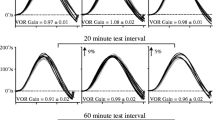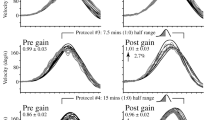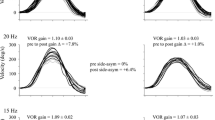Abstract
We sought to determine whether repeated vestibulo-ocular reflex (VOR) adaptation training to increase the VOR gain (eye/head velocity) had a lasting effect in normal subjects and whether there was a retinal image slip tolerance threshold for VOR adaptation. We used the unilateral incremental VOR adaptation technique and horizontal active (self-generated, predictable) head impulses as the vestibular stimulus. Both active and passive (imposed, unpredictable) head impulse VOR gains were measured before and after unilateral incremental VOR adaptation training. The adapting side was pseudo-randomized for left or right. We tested ten normal subjects over one block (10 sessions over 12 days) of VOR adaptation training and testing, immediately followed by a second block (5 sessions over 19 days) of testing only without training. Our findings show robust short-term VOR adaptation of ~ 10 % immediately after each 15-min training session, but that the daily pre-adaptation gain was most different on days 1 and 2, and for subsequent training days before saturating to ~ 5 % greater than the pre-adaptation gain on day 1. This increase was partially retained for 19 days after regular training stopped. The data suggest that stable vision in normal subjects is maintained when there is < 5 % deviation in VOR gain from the original baseline, which corresponds to < 9°/s retinal image slip. Below this threshold, there is poor adaptive drive to return the gain to its original baseline value.


Similar content being viewed by others
References
Fadaee SB, Migliaccio AA (2016) The effect of retinal image error update rate on human vestibule-ocular reflex gain adaptation. Exp Brain Res 234:1085–1094
Gauthier GM, Robinson DA (1975) Adaptation of the human vestibuloocular reflex to magnifying lenses. Brain Res 92:331–335
Gimmon Y, Migliaccio AA, Kim KJ, Schubert MC (2019) VOR adaptation training and retention in a patient with profound bilateral vestibular hypofunction. Laryngoscope. https://doi.org/10.1002/lary.27838
Gonshor A, Melvill JG (1976a) Short-term adaptive changes in the human vestibulo-ocular reflex arc. J Physiol 256:361–379
Gonshor A, Melvill JG (1976b) Extreme vestibulo-ocular adaptation induced by prolonged optical reversal of vision. J Physiol 256:381–414
Grossman GE, Leigh RJ, Abel LA, Lanska DJ, Thurston SE (1988) Frequency and velocity of rotational head perturbations during locomotion. Exp Brain Res 70:470–476
Halmagyi GM, Curthoys IS (1988) A clinical sign of canal paresis. Arch Neurol 45:737–739
Mahfuz MM, Schubert MC, Todd CJ, Figtree WVC, Khan SI, Migliaccio AA (2018a) The effect of visual contrast on human vestibulo-ocular reflex training. J Assoc Res Otolaryngol 19:113–122
Mahfuz MM, Schubert MC, Figtree WVC, Todd CJ, Khan SI, Migliaccio AA (2018b) Optimal human passive vestibulo-ocular reflex adaptation does not rely on passive training. J Assoc Res Otolaryngol 19:261–271
Mahfuz MM, Schubert MC, Figtree WVC, Todd CJ, Migliaccio AA (2018c) Human vestibulo-ocular reflex adaptation: consolidation time between repeated training blocks improves retention. J Assoc Res Otolaryngol 19:601–610
Mahfuz MM, Schubert MC, Figtree WVC, Todd CJ, Migliaccio AA (2018d) Human vestibulo-ocular reflex adaptation training: time beats quantity. J Assoc Res Otolaryngol 19:729–739
Migliaccio AA, Schubert MC (2013) Unilateral adaptation of the human angular vestibulo-ocular reflex. J Assoc Res Otolaryngol 14:29–36
Migliaccio AA, Schubert MC (2014) Pilot study of a new rehabilitation tool: improved unilateral short-term adaptation of the human angular vestibulo-ocular reflex. Otol Neurotol 35:310–316
Paige GD, Sargent EW (1991) Visually-induced adaptive plasticity in the human vestibulo-ocular reflex. Exp Brain Res 84:25–34
Rinaudo CN, Schubert MC, Cremer PD, Figtree WVC, Todd CJ, Migliaccio AA (2019a) Improved oculomotor physiology and behavior after unilateral incremental adaptation training in a person with chronic vestibular hypofunction: case report. Phys Ther. https://doi.org/10.1093/ptj/pzz083
Rinaudo CN, Schubert MC, Figtree WVC, Todd CJ, Migliaccio AA (2019b) Human vestibulo-ocular reflex adaptation is frequency-selective. J Neurophysiol 122:984–993
Schubert MC, Migliaccio AA (2016) Stability of the aVOR to repeat head impulse testing. Otol Neurotol 37:781–786
Schubert MC, Della Santina CC, Shelhamer M (2008) Incremental angular vestibulo-ocular reflex adaptation to active head rotation. Exp Brain Res 191:435–446
Schubert MC, Migliaccio AA, Ng T, Shaikh AG, Zee DS (2012) The under-compensatory roll aVOR does not affect dynamic visual acuity. J Assoc Res Otolaryngol 13:517–525
Todd CJ, Hübner PP, Hübner P, Schubert MC, Migliaccio AA (2018) StableEyes–a portable vestibular rehabilitation device. IEEE Trans Neural Syst Rehabil Eng 26:1223–1232
Todd CJ, Schubert MC, Figtree WVC, Migliaccio AA (2019) Incremental vestibulo-ocular reflex adaptation training dynamically tailored for each individual. J Neurol Phys Ther 43(Suppl 2 Supplement, Special Supplement: International Conference on Vestibular Rehabilitation):S2–S7
Walker MF, Zee DS (1999) Directional abnormalities of vestibular and optokinetic responses in cerebellar disease. Ann N Y Acad Sci 871:205–220
Acknowledgements
A.A. Migliaccio was supported by The Garnett Passe and Rodney Williams Memorial Foundation Senior/Principal Research Fellowship in Otorhinolaryngology and Project Grant (2013-15), and NHMRC Development Grant APPI05550.
Author information
Authors and Affiliations
Corresponding author
Ethics declarations
Participation in this study was voluntary and informed consent was obtained as approved by the University of New South Wales Human Ethics Committee.
Additional information
Publisher’s Note
Springer Nature remains neutral with regard to jurisdictional claims in published maps and institutional affiliations.
Rights and permissions
About this article
Cite this article
Mahfuz, M.M., Schubert, M.C., Figtree, W.V.C. et al. Retinal Image Slip Must Pass the Threshold for Human Vestibulo-Ocular Reflex Adaptation. JARO 21, 277–285 (2020). https://doi.org/10.1007/s10162-020-00751-6
Received:
Accepted:
Published:
Issue Date:
DOI: https://doi.org/10.1007/s10162-020-00751-6




